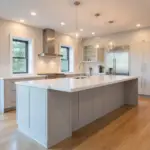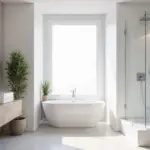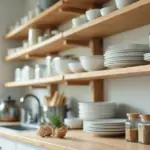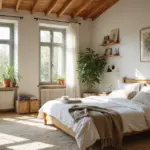Is your kitchen stuck in a time warp? Do you find yourself dreaming of a space that feels both beautiful and practical? As the heart of your home, your kitchen deserves to be a place you genuinely love spending time in.
Whether you’re contending with outdated cabinets, cramped countertops, or simply need a fresh dose of inspiration, these kitchen renovation ideas will breathe new life into your culinary space. I’ve curated 18 transformative concepts that range from simple weekend updates to complete reimaginings—all designed to help you create a kitchen that truly reflects your style and meets your needs.
1. Embrace Open Shelving for an Airy, Modern Kitchen
Open shelving instantly transforms the feel of a kitchen, creating a spacious atmosphere that makes even the most compact kitchens feel more generous. Beyond the visual expansion, open shelves offer a canvas to showcase your personality—imagine your beautiful ceramics and gleaming copper pots becoming part of your décor rather than hidden behind cabinet doors. They also improve functionality by putting everything at your fingertips, streamlining both cooking and cleaning routines.

Of course, open shelving isn’t without its considerations. Dust accumulation means regular maintenance is essential, and because everything is on display, maintaining a tidy appearance becomes more important. Consider combining open shelving with traditional cabinets for the best of both worlds—display your most attractive pieces while keeping everyday essentials neatly tucked away.
Picture it this way: a coffee station with open shelving displaying your favorite mugs and coffee beans becomes not just functional but a delightful visual moment in your kitchen. This approach to shelving reconnects with kitchen design history—before mass-produced cabinetry became standard, open storage was the norm in many homes.
2. Create a Central Hub with a Kitchen Island
The allure of a kitchen island lies in its remarkable versatility. Beyond dramatically increasing your counter space, an island provides valuable storage through drawers and cabinets while creating a natural gathering spot. With the addition of bar stools, it transforms into a casual dining area perfect for morning coffee or after-school snacks. Islands naturally become the heart of the kitchen—a place for food preparation that doubles as a social hub.

Before you dive into island dreams, space planning is crucial. The magic number to remember is 42-48 inches—that’s the ideal clearance around your island for comfortable movement. Without adequate space, an island can create bottlenecks and frustration. Measure meticulously and consider a rolling island for smaller kitchens that need flexibility.
The heart of the matter is that islands revolutionize how we use our kitchens. They’ve evolved from the freestanding tables of earlier eras into multifunctional centerpieces—many now featuring integrated wine storage, specialized drawers for spices, or even secondary sinks. As we shift our focus from the central island to the surrounding surfaces, let’s explore how countertops can dramatically change both the look and functionality of your kitchen.
3. Upgrade to Stunning and Durable Countertops
Countertops are the workhorses of the kitchen, enduring daily use while setting the style tone for the entire space. The right countertop material balances beauty, durability, and budget in a way that complements your lifestyle. Granite brings unique natural patterns and excellent heat resistance but requires periodic sealing. Quartz offers incredible durability and low maintenance but comes with a higher price tag. Marble exudes timeless elegance but demands more careful treatment to prevent staining.
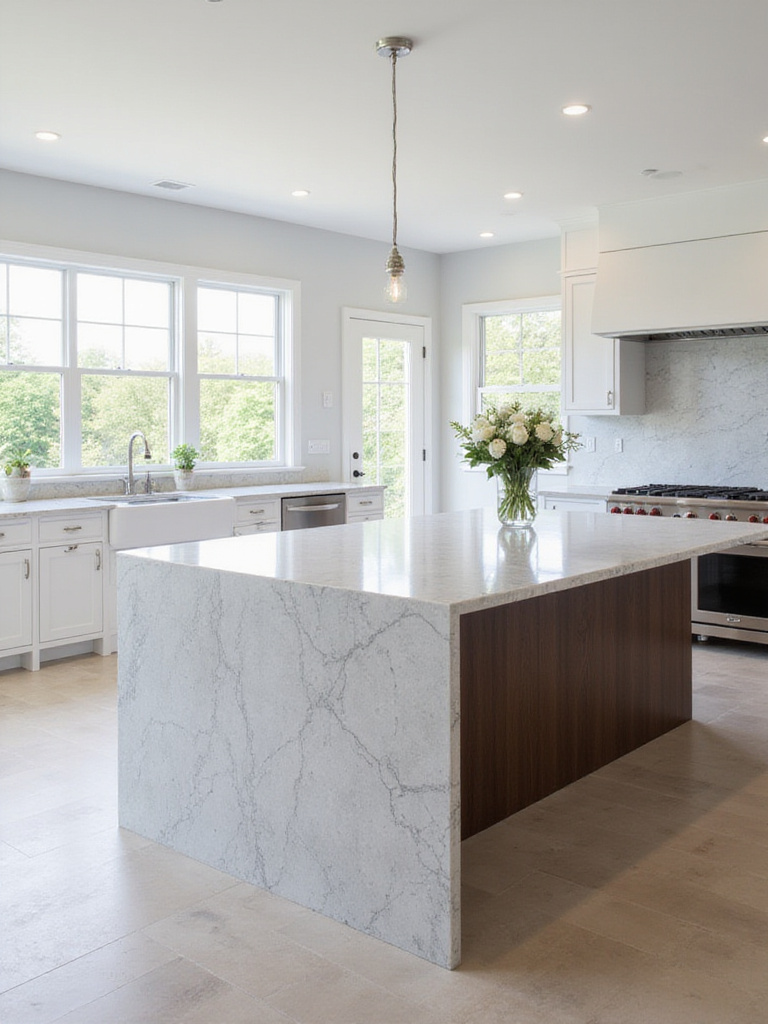
Your choice should reflect how you actually use your kitchen. If you’re an avid baker, consider a section of cool marble for pastry work alongside more durable surfaces for everyday use. For busy families, quartz offers peace of mind with its resistance to stains and scratches. Budget-conscious renovators might explore higher-end laminates with realistic stone-look finishes that deliver impressive style without the premium cost.
The missing piece in many kitchen renovation ideas is thoughtful material testing. Before committing, bring home samples of your favorite countertop materials and subject them to common kitchen spills—coffee, wine, tomato sauce—to see how they react and how easily they clean. As we move from horizontal surfaces to vertical ones, let’s explore how a new backsplash can inject personality into your kitchen design.
4. Revamp Your Kitchen with a Statement Backsplash
A backsplash serves dual purposes: protecting your walls from splashes and stains while creating a canvas for personal expression. This relatively small area can become the focal point that ties your entire kitchen design together. Classic subway tile offers timeless appeal and endless arrangement possibilities, while glass backsplashes provide sleek, contemporary flair. Natural stone brings organic texture, and metal options like stainless steel or copper create industrial chic vibes.

When selecting your backsplash, consider both aesthetics and practicality. Areas behind the stove benefit from easy-to-clean materials without grout lines that can trap grease. For budget-friendly options, peel-and-stick tiles have come a long way in quality and can be a DIY-friendly weekend project. For maximum impact, create a feature wall behind the stove with a decorative tile pattern or mosaic that contrasts with simpler surroundings.
The surprising part is how this relatively small area can completely transform your kitchen’s personality. Did you know subway tile—now a kitchen classic—originated in the New York City subway system in the early 1900s? Its clean lines and versatility have made it a design staple for over a century. Now, let’s shift our focus to perhaps the most budget-friendly kitchen renovation idea that delivers dramatic results: paint.
5. Transform Your Space with Strategic Paint Choices
Paint stands out as the renovation project that delivers the most visual impact for the least investment. A fresh coat can instantly brighten a tired kitchen, effectively hiding imperfections while completely altering the mood. The transformation can be remarkable—from dark and dated to bright and contemporary in a weekend’s work. Best of all, it’s a relatively simple DIY project requiring minimal tools and expertise.

The kitchen color trends for 2024 lean toward earthy tones and soft neutrals. Sage green cabinets offer sophisticated calm while pairing beautifully with natural materials. Navy blue provides dramatic elegance, particularly effective for islands or lower cabinets. For walls, light gray continues as a versatile neutral, while soft terracotta brings warmth and earthiness that feels both fresh and timeless.
What complicates this seemingly simple kitchen renovation idea is that color affects more than just aesthetics—it influences mood and even appetite. Warmer colors like red and orange stimulate hunger, while cooler blues and greens create a more calming environment. Consider how you use your kitchen and the atmosphere you want to create when selecting your palette. With our newly painted kitchen glowing with fresh color, let’s illuminate it properly with updated lighting fixtures.
6. Illuminate Your Kitchen with Layered Lighting
Updated lighting is essential for creating both a functional and welcoming kitchen. From a practical standpoint, proper illumination dramatically improves visibility for food preparation, reducing accidents and making cooking more enjoyable. Aesthetically, thoughtful lighting transforms the mood of your space, highlighting architectural features and creating a warm, inviting atmosphere.

The key to successful kitchen lighting lies in incorporating three distinct types: ambient, task, and accent. Ambient lighting provides overall illumination through recessed fixtures or ceiling-mounted options. Task lighting focuses on specific work areas—under-cabinet lighting illuminates countertops, while pendant lights over islands ensure you can see what you’re chopping. Accent lighting adds depth by highlighting architectural details or display areas, often through strip lighting or strategic spotlights.
Here’s where everything changes: today’s smart lighting systems allow you to control brightness and even color temperature based on time of day or activity. Imagine bright, energizing light for morning meal prep that transitions to a warm, intimate glow for evening dining—all controlled by voice commands or automated schedules. With our kitchen now brilliantly illuminated, let’s focus on another hardworking element: the sink and faucet.
7. Upgrade Your Kitchen Sink and Faucet for Style and Function
The kitchen sink is one of the most frequently used areas in the home, making it a prime target for kitchen renovation ideas that boost both function and beauty. Material choices range from durable stainless steel to elegant fireclay farmhouse sinks, each offering different aesthetics and maintenance requirements. Size and configuration matter too—do you need a large single bowl for washing oversized pots, or would a double bowl better suit your dishwashing routine?

Faucet technology has evolved dramatically, offering features that make kitchen tasks easier. Pull-down sprayers provide flexibility for cleaning large items, while touchless operation keeps your faucet clean even when your hands aren’t. For serious cooks, pot fillers mounted near the stove eliminate the need to carry heavy water-filled pots across the kitchen. Consider how you use your sink daily to determine which features would most improve your cooking and cleaning routines.
The breakthrough came when manufacturers began treating kitchen fixtures as design elements rather than purely functional necessities. Today’s sinks and faucets can be statement pieces that anchor your kitchen’s style—whether that’s industrial chic with a commercial-style faucet or farmhouse warmth with an apron-front sink. As we continue our kitchen renovation ideas journey, let’s consider how upgrading appliances can benefit both the planet and your utility bills.
8. Invest in Energy-Efficient Appliances
Upgrading to energy-efficient appliances offers a triple benefit: environmental responsibility, lower utility bills, and improved performance. Modern Energy Star appliances typically use 20% less energy than standard models, creating savings that accumulate year after year. Many energy-efficient options also qualify for rebates and tax credits, helping offset the initial purchase cost.

When selecting energy-efficient kitchen appliances, look beyond the Energy Star label to specific features that enhance efficiency. Refrigerators with adjustable humidity controls optimize food storage conditions, reducing waste. Dishwashers with soil sensors automatically adjust water usage based on how dirty your dishes actually are. Convection ovens cook food faster and more evenly, using less energy in the process.
“The most sustainable appliance is often the one that helps you waste less food. Look for refrigerators with proper humidity controls and visibility that helps you use what you have before it spoils.” – Ava Sinclair-Patel
The game-changer happened as appliance manufacturers began focusing not just on energy consumption but on how technology could make our kitchens more efficient overall. This thinking extends beyond traditional appliances into the world of smart kitchen technology, our next exciting kitchen renovation idea.
9. Integrate Smart Gadgets and Appliances
Smart technology is transforming kitchens into more connected, efficient spaces that anticipate our needs and streamline our cooking processes. The convenience factor is substantial—imagine preheating your oven remotely, starting your coffee maker with a voice command, or checking your refrigerator’s contents while grocery shopping. These capabilities aren’t just novelties; they represent a fundamental shift in how we interact with our kitchens.

The range of smart kitchen options continues to expand impressively. Smart refrigerators with built-in cameras let you peek inside remotely, while inventory management systems track expiration dates and suggest recipes based on what you have on hand. Smart ovens offer guided cooking programs that adjust temperature and timing automatically for perfect results. Even smaller appliances like precision cookers and connected coffee makers bring professional-level control to everyday cooking tasks.
Do you see how huge that is? We’re moving beyond simple convenience to kitchens that actually help us become better, more efficient cooks while reducing waste and saving time. The first smart refrigerator appeared in 2000 with basic internet connectivity—today’s models are essentially kitchen computers that help manage your food, cooking, and even family scheduling. As impressive as smart technology is, let’s now consider how custom cabinetry can create the perfect foundation for your high-tech kitchen.
10. Design Custom Cabinetry for Perfect Storage Solutions
Custom cabinetry offers unparalleled personalization that addresses the unique dimensions of your kitchen and your specific storage needs. Unlike pre-fabricated options, custom cabinets maximize every inch of available space, elegantly solving awkward corners and seamlessly integrating appliances. This level of customization allows you to create a kitchen that functions precisely the way you need it to, with specialized storage for everything from wine bottles to baking sheets.

The true beauty of custom cabinets lies in the thoughtful internal organization features that transform how you use your kitchen. Consider these game-changing elements:
- Pull-out shelves that bring items at the back of cabinets within easy reach
- Vertical dividers for storing baking sheets and cutting boards upright
- Deep drawers with soft-close mechanisms for pots and pans
- Specialized storage for spices, oils, and cooking utensils near the stove
- Corner cabinet solutions like lazy susans or pull-out organizers
The tricky part is balancing beauty with function. Work with a skilled cabinet designer who understands both the aesthetic and practical aspects of kitchen design. The oldest known kitchen cabinets date back to ancient Egypt, where they stored food and cooking implements—today’s versions continue this essential function while adding considerable style and sophistication. Speaking of organization, let’s expand our storage thinking to include the pantry, often a challenging space to keep orderly.
11. Optimize Your Pantry for Maximum Efficiency
A well-organized pantry is more than just aesthetically pleasing—it’s about maximizing space, minimizing food waste, and streamlining your entire cooking process. During a kitchen renovation, you have the perfect opportunity to reassess your pantry needs and design a system that truly works for your lifestyle. An optimized pantry means easily finding ingredients, avoiding duplicate purchases, and keeping track of what you have on hand.

Key elements of efficient pantry design include adjustable shelving to accommodate items of various heights, pull-out drawers for easy access to items stored at the back, and clear containers that provide instant visibility of contents. Proper lighting inside the pantry is crucial yet often overlooked—illuminating the entire space makes it easy to find items, even on lower shelves. Creating designated zones for different food categories (baking supplies, snacks, canned goods) further enhances organization and efficiency.
My breakthrough came when I realized that pantry organization should reflect how you actually cook, not just generic storage principles. If you bake frequently, group those ingredients together. If you pack lunches daily, create a dedicated zone for grab-and-go items. The word “pantry” comes from the Old French “paneterie,” meaning “bread room”—a reminder that these spaces have been essential to kitchens for centuries. Now, let’s look downward to another foundational element of kitchen renovation ideas: flooring.
12. Choose New Flooring to Transform Your Kitchen’s Foundation
Kitchen flooring takes a beating from spills, dropped utensils, and constant foot traffic, making durability and water resistance paramount considerations. Porcelain tile excels in these areas while offering endless style options that can mimic everything from natural stone to wood. Luxury Vinyl Plank (LVP) has surged in popularity for its excellent water resistance, scratch resistance, and comfortable feel underfoot. For those seeking natural materials, engineered hardwood offers the warmth of wood with better moisture resistance than traditional hardwood.

Your flooring choice significantly impacts the overall feel of your kitchen. Light-colored flooring brightens small kitchens, making them feel more spacious, while dark flooring adds warmth and sophistication to larger spaces. The pattern and installation method also influence the aesthetic—herringbone patterns create visual interest, while large-format tiles with minimal grout lines offer a sleek, modern look. For a cohesive design, choose flooring that complements your cabinets, countertops, and backsplash.
Let me paint you a picture: linoleum, a sustainable flooring option made from natural materials like linseed oil and wood flour, was once considered outdated but has made a remarkable comeback in eco-friendly kitchen renovation ideas. Today’s versions come in stunning patterns and colors that bear little resemblance to the linoleum of decades past. With durable flooring underfoot, let’s look up to the windows and consider how to maximize natural light.
13. Enhance Natural Light with Stylish Window Treatments
Natural light creates a bright, welcoming atmosphere that makes any kitchen feel more inviting. The key to maximizing this precious resource lies in selecting window treatments that filter light beautifully while providing appropriate privacy and style. Sheer curtains gently diffuse light while maintaining brightness, while light-filtering shades offer privacy without blocking daylight entirely. Blinds with wide slats can be angled to redirect sunlight upward, bouncing light deeper into the kitchen.

For kitchens that need both light control and privacy, several stylish options stand out. Roman shades provide a clean, tailored look and can be raised or lowered to adjust light levels. Cellular shades offer excellent insulation and come in varying opacities for customized light filtration. A clever solution for privacy without sacrificing light is using frosted glass film on the lower portion of windows, obscuring the view from outside while still allowing ample light to enter.
Things took an interesting turn when I realized the direction your kitchen window faces significantly impacts lighting strategy. South-facing windows receive the most sunlight throughout the day, sometimes requiring treatments that prevent glare and overheating. North-facing windows provide softer, more diffused light that rarely causes glare but might need less filtering. This natural illumination creates the perfect setting for our next kitchen renovation idea: a cozy breakfast nook.
14. Create a Charming Breakfast Nook for Casual Dining
A breakfast nook transforms an underutilized corner of your kitchen into a delightful spot for morning coffee, casual meals, or homework sessions. The best breakfast nooks blend comfort, functionality, and appealing aesthetics to create a space that invites lingering conversations. Comfortable seating is essential—whether through cushioned benches, inviting upholstered chairs, or a space-saving banquette that follows the contours of your kitchen.

Functionality comes from having an appropriately sized table and incorporating clever storage solutions, such as drawers under bench seating for placemats, napkins, or table linens. Good lighting creates a warm ambiance—consider a pendant light or wall sconces in addition to natural light from nearby windows. The breakfast nook should complement your overall kitchen design while feeling distinct enough to create a separate dining zone.
What unfolded next was fascinating: breakfast nooks originated in the early 20th century as a response to smaller, more efficient kitchens. They provided dedicated dining areas that didn’t require the space of formal dining rooms—a practical solution that became a beloved design feature. Today’s nooks continue this tradition of combining practicality with charm. As we enhance our kitchen with cozy seating, let’s also consider how natural materials can bring warmth and organic beauty to the space.
15. Bring the Outdoors In with Natural Elements
Incorporating natural elements like wood and stone in your kitchen renovation creates a warm, inviting atmosphere that connects us to the natural world. These materials bring rich textures and natural variations in color and pattern, adding depth and visual interest to kitchen design. The contrast between organic textures and the sleek lines of modern appliances creates a visually appealing aesthetic that feels both contemporary and timeless.
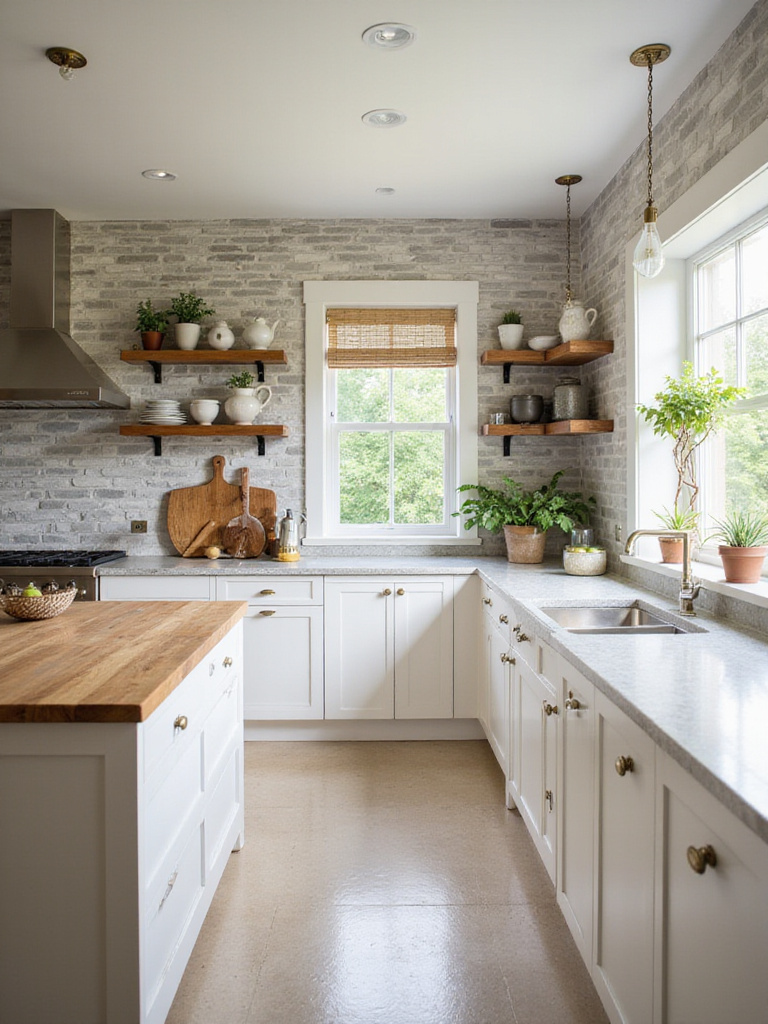
When selecting wood and stone for your kitchen, consider their practical attributes alongside their beauty. For wood, evaluate the grain pattern, color tone, and durability of different species—oak, maple, and walnut are popular choices for cabinetry and flooring due to their resistance to wear. For stone, consider porosity, stain resistance, and maintenance requirements. Granite and quartz remain excellent countertop choices for their exceptional durability and resistance to staining.
“The magic happens when you juxtapose natural materials with modern elements—perhaps a sleek quartz countertop alongside warm wooden open shelving, or contemporary cabinets with a stunning stone backsplash. This balance creates kitchens that feel both current and timeless.” – Ava Sinclair-Patel
It’s similar to how we feel more relaxed and centered in natural settings—bringing these elements indoors creates kitchens that feel calming and grounded despite the busy activity they host. Now, let’s explore how to maximize every inch of this nature-inspired kitchen with clever storage solutions.
16. Maximize Every Inch with Clever Storage Design
In a busy kitchen, efficient storage transforms daily cooking from chaotic to choreographed. The first step in planning storage solutions is analyzing your cooking style and habits—consider how frequently you use different items and what storage challenges currently frustrate you. Utilize vertical space by extending cabinets to the ceiling and incorporating tall pantry units. Address corner cabinets with lazy susans or pull-out shelving to make the most of these often-awkward spaces.

Maximizing storage in smaller kitchens requires even more creativity. Pull-out shelves and organizers prevent items from getting lost in the back of cabinets. Wall-mounted magnetic knife strips and hanging pot racks free up precious counter and drawer space. Don’t overlook the backs of cabinet doors—hang organizers for spices, cleaning supplies, or utensils to add storage in unexpected places. Embrace a minimalist approach by regularly decluttering and keeping only essential items within easy reach.
The crucial element is personalizing your storage to match how you actually use your kitchen. The average kitchen contains over 40 different appliances and utensils—organizing these effectively makes the difference between a frustrating cooking experience and an enjoyable one. With our storage solutions in place, let’s look at a simple yet impactful kitchen renovation idea: updating cabinet hardware.
17. Instantly Update Cabinets with New Hardware
Changing cabinet hardware is a surprisingly powerful mini-renovation that delivers significant impact without major disruption. New knobs and pulls can dramatically shift the style of your kitchen, instantly modernizing outdated cabinets or adding character to plain ones. It’s a relatively small investment that yields an impressive return in terms of visual appeal and updated style—perfect for rental properties or when budget constraints limit larger changes.

The right hardware style depends on your overall kitchen design and personal taste. Modern kitchens benefit from sleek, minimalist hardware with clean lines in finishes like brushed nickel or matte black. Traditional kitchens call for more decorative pieces with classic finishes such as antique brass or oil-rubbed bronze. For a touch of unexpected personality, consider mixing finishes—perhaps brass knobs on upper cabinets with black pulls on lowers—or choosing unique materials like leather pulls or colored glass knobs.
The stumbling block is often in the details—ensuring new hardware fits existing holes or creating a template for consistent placement if drilling new ones. Cabinet hardware can be crafted from various materials including metal, wood, glass, ceramic, and even leather, each bringing different tactile experiences to daily kitchen use. As we complete these smaller updates, let’s consider the most transformative kitchen renovation idea of all: reconfiguring the entire layout.
18. Reconfigure Your Kitchen Layout for Better Flow
A well-designed kitchen layout is the foundation of efficient workflow, safety, and enjoyment of your space. An optimized layout minimizes wasted steps between work areas, prevents bottlenecks during meal preparation, and ensures that frequently used items are logically placed. Investing in layout reconfiguration can transform a frustrating kitchen into a joy to cook in—perhaps the most impactful of all kitchen renovation ideas.

Several kitchen layout types exist, each suited to different spaces and needs. The classic work triangle—connecting sink, stove, and refrigerator—remains a useful concept, but modern kitchens often incorporate multiple work zones for different activities. The one-wall kitchen maximizes space efficiency in small apartments. Galley kitchens offer efficient workflow in narrow spaces. L-shaped kitchens provide good workflow while allowing for open-plan design. U-shaped kitchens deliver ample counter space and storage, while island kitchens add a central work/gathering space to any of these configurations.
The ripple effects are enormous when you get your kitchen layout right. One client moved her sink under a window, creating a pleasant view while washing dishes—a simple change that made a daily chore more enjoyable. Kitchen renovations consistently show one of the highest returns on investment compared to other home improvement projects, particularly when they improve functionality through thoughtful layout changes.
Creating Your Dream Kitchen
Kitchen renovation ideas range from simple weekend projects to comprehensive transformations, each offering opportunities to enhance both beauty and functionality. Whether you’re refreshing cabinet hardware, installing energy-efficient appliances, or completely reconfiguring your layout, the goal remains the same: creating a kitchen that works for your lifestyle while reflecting your personal style.
The most successful kitchen renovations balance trends with timelessness, incorporating elements that feel current while avoiding choices that might quickly date. By focusing on quality materials, thoughtful storage solutions, and efficient layouts, you’ll create a kitchen that not only looks beautiful today but continues to function beautifully for years to come.
What kitchen renovation ideas are you most excited to implement in your space? Whether you’re planning a complete overhaul or looking for weekend updates, these 18 ideas offer inspiration for kitchens of every size and style. The heart of your home deserves thoughtful attention—and the rewards of a well-designed kitchen enhance daily life in countless ways.

